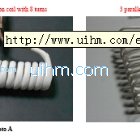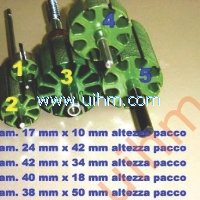MELT REFRACTORY METALS WITH INDUCTION HEATING
2013/5/16 Views
In the Ail-Union Scientific-Research Tube Institute's industrial induction electric furnaces heated to 2000-2300°C, cylindrical billets of high-melting alloys are placed on refractory supports. To select materials for the supports which do not react with molybdenum billets below 2000-2300°C, and to ensure their normal operation, we have investigated the reaction of molybdenum with zirconium and hafnium dioxides, stabilized with CaO and Y2O3, and its reactions with yttrium oxide and zirconium—hafnium solid solutions. 
The tests were performed by the contact method and by the active powder method at 2000-2300°C in vacuum under a pressure of 1.33-lO-2 Pa [1, 2], The changes in the specimens after the tests were monitored by petrographic, x-ray structural, and chemical methods. Laboratory investigations confirmed for Zr02, and established for Hf02 and Y203, the absence of visible reaction of these materials with molybdenum below 2000°C. Above 2000°C, at the contact of monoclinic Zr02 and Hf02 supports with molybdenum we observed a certain loss of oxygen, with consequent appearance of a cubic phase; this agrees with [1, 2].
According to microscopic investigations, above 2000°C a monoclinic phase appeared in CaO-stabilized Zr02 specimens at the contact with molybdenum; this is attributable to partial evaporation of CaO and destabilization of the cubic phase. The destabilized layer was too thin (less than 0.5 mm) to separate it for chemical analysis. Destabilization of the working layer was not observed in specimens of Zr02 stabilized with Y203, which form solid solutions; this agrees with [3], On the basis of our data, supports for the tests were made on the basis of zirconium dioxide, completely or partly stabilized with CaO and Y203, and also on the basis of zirconium—hafnium solid solutions. The composition and properties of the supports are given in Table 1

The tests were performed by the contact method and by the active powder method at 2000-2300°C in vacuum under a pressure of 1.33-lO-2 Pa [1, 2], The changes in the specimens after the tests were monitored by petrographic, x-ray structural, and chemical methods. Laboratory investigations confirmed for Zr02, and established for Hf02 and Y203, the absence of visible reaction of these materials with molybdenum below 2000°C. Above 2000°C, at the contact of monoclinic Zr02 and Hf02 supports with molybdenum we observed a certain loss of oxygen, with consequent appearance of a cubic phase; this agrees with [1, 2].
According to microscopic investigations, above 2000°C a monoclinic phase appeared in CaO-stabilized Zr02 specimens at the contact with molybdenum; this is attributable to partial evaporation of CaO and destabilization of the cubic phase. The destabilized layer was too thin (less than 0.5 mm) to separate it for chemical analysis. Destabilization of the working layer was not observed in specimens of Zr02 stabilized with Y203, which form solid solutions; this agrees with [3], On the basis of our data, supports for the tests were made on the basis of zirconium dioxide, completely or partly stabilized with CaO and Y203, and also on the basis of zirconium—hafnium solid solutions. The composition and properties of the supports are given in Table 1
Down Attachment
- DownloadAttach1: MELT REFRACTORY METALS WITH INDUCTION HEATING.pdf Clicks
Good
Bad






Newest Comment
No Comment
Post Comment